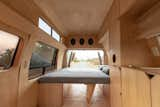This Chevy Camper Van’s Wondrous Wooden Interior Will Make You Look Twice
Ecuadorian couple Diego Sayago and Tatiana Salas—a lawyer and an environmental engineer—bought a 1993 Chevy van with dreams of turning it into a place where they could live while traveling to remote communities for their work. At first they planned to refurbish the van themselves, but they soon realized they needed design expertise to successfully transform the tiny interior space—so they approached Juan Alberto Andrade, María José Váscones, and Cuqui Rodriguez.
"They wanted to equip the van with basic living needs—a place to rest, work, cook, and eat," says Andrade. "Our purpose was to solve the architectural program by designing and implementing flexible furniture that can produce different configurations according to these needs."
Diego and Tatiana named their vehicle the Dodo Van—after the late bird species—to remind themselves not to let their dreams become extinct. "Diego’s plan is to travel around the country, getting to know new places, while Tatiana wants to educate people about a sustainable lifestyle and ecological materials," says Váscones. "They were able to bring their wishes to life through the van, and the name reminds them to keep their dreams alive."
The van’s interior measures about 54 square feet, so it was essential that the space could adapt to different living functions. The solution is a clever system of built-in plywood joinery that can fold, assemble, and pull out to offer space to sleep, prepare food, eat, and relax.
The living area is divided into three distinct zones, with two entrances—lateral doors on the right, and doors at the back. Entering the van through the right side leads to the kitchenette, with a window to the outside. The middle of the van holds a foldable kitchen countertop next to a cooking area, and the rear of the van features seating that folds out to become a double bed. The design team integrated storage space wherever possible throughout the entire van.
"An analysis of tiny houses led us to the conclusion that flexibility is the main attribute when solving an architectural program with basic living needs in a space limited by square footage," says Andrade.
The design team initially planned to work with solid timber, but eventually they decided to craft the interior from plywood boards of various thicknesses, which are lighter and more easily molded. "Given that the van has a very specific shape, it was necessary to work with a material that could adapt to the morphology of it, preserving the van’s structure," says Váscones. "Working with one material also made the space monochromatic, so it could seem open and wider."
The van also needed to provide all the necessities for comfortable living. The kitchenette has running water thanks to a system of storage tanks that hold both clean and used water, and there is an independent battery connected to the vehicle’s alternator, a 110v transformer, light fixtures, and three outlets for charging appliances and devices. The floor, walls, and ceiling of the Dodo Van are insulated with thermoacoustic mineral wool that protects the interior from noise and the elements.
"The clients were very moved with the completed project," says Andrade. "They liked that you could still perceive the shape of the van, and how comfortable and spacious it felt. Tatiana sent me a message after it was completed saying, ‘Thank you for making this dream of ours come to life.’"
Related Reading:
An Ecuador Couple Seek Out Adventure in a DIY Tiny Cabin on Wheels
Budget Breakdown: A Climbing Couple Turn a Delivery Van Into an Adventure Mobile for $8.5K
Project Credits:
Architects of Record: Juan Alberto Andrade / @juanalbertoandrade.ec, María José Váscones
Collaborator: Cuqui Rodriguez
Materials & Hardware: Mega Metales, Mega Kywi, & Acimco
Local Hand Work: Eusebio Tomalá
Photography: JAG Studio
Published
Last Updated
Topics
Campers & TrailersGet the Dwell Newsletter
Be the first to see our latest home tours, design news, and more.















